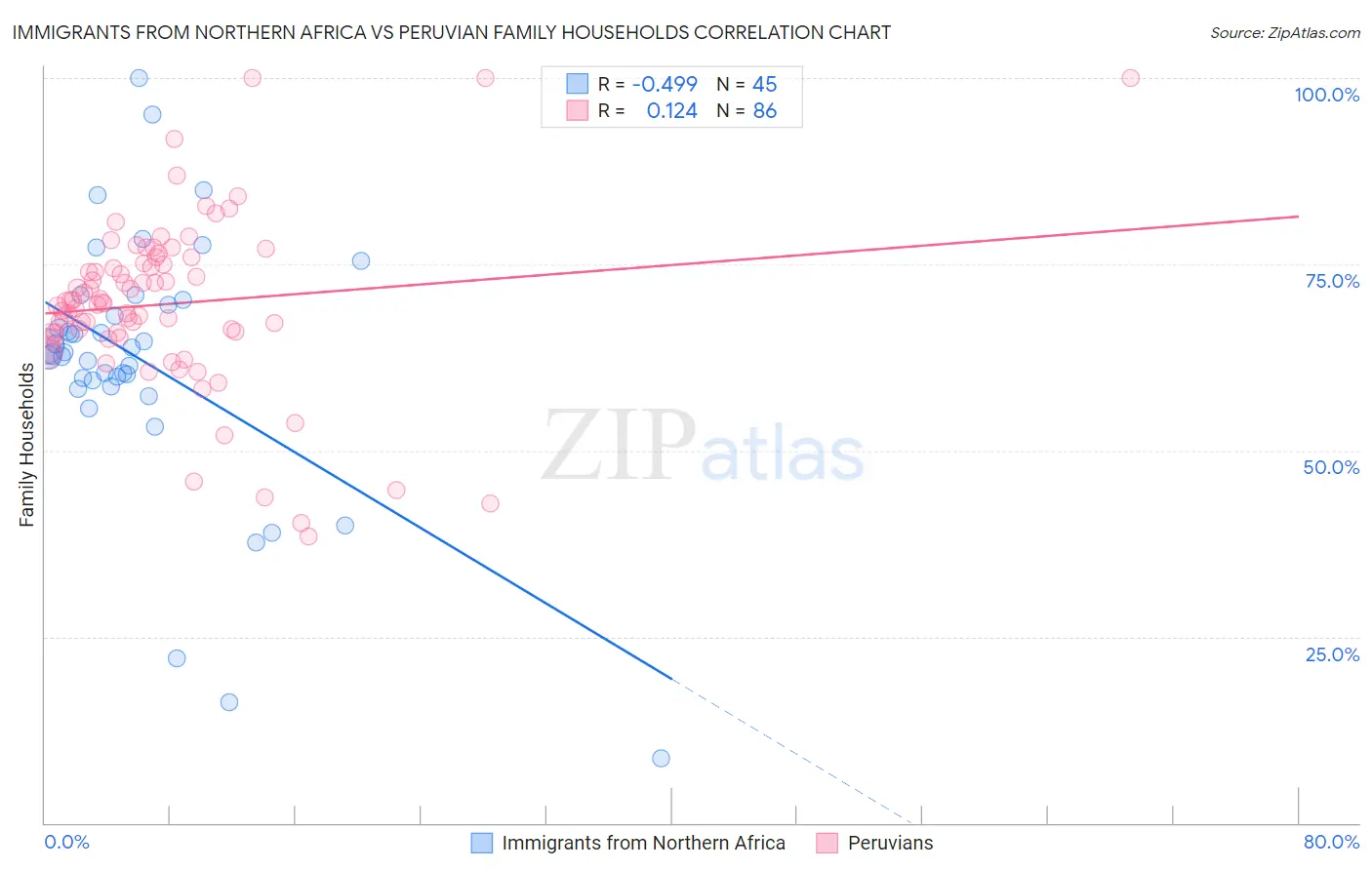Immigrants from Northern Africa vs Peruvian Family Households
COMPARE
Immigrants from Northern Africa
Peruvian
Family Households
Family Households Comparison
Immigrants from Northern Africa
Peruvians
63.5%
FAMILY HOUSEHOLDS
2.6/ 100
METRIC RATING
232nd/ 347
METRIC RANK
67.1%
FAMILY HOUSEHOLDS
100.0/ 100
METRIC RATING
36th/ 347
METRIC RANK
Immigrants from Northern Africa vs Peruvian Family Households Correlation Chart
The statistical analysis conducted on geographies consisting of 321,089,077 people shows a moderate negative correlation between the proportion of Immigrants from Northern Africa and percentage of family households in the United States with a correlation coefficient (R) of -0.499 and weighted average of 63.5%. Similarly, the statistical analysis conducted on geographies consisting of 362,986,655 people shows a poor positive correlation between the proportion of Peruvians and percentage of family households in the United States with a correlation coefficient (R) of 0.124 and weighted average of 67.1%, a difference of 5.7%.

Family Households Correlation Summary
| Measurement | Immigrants from Northern Africa | Peruvian |
| Minimum | 8.7% | 38.4% |
| Maximum | 100.0% | 100.0% |
| Range | 91.3% | 61.6% |
| Mean | 62.0% | 69.7% |
| Median | 63.2% | 69.8% |
| Interquartile 25% (IQ1) | 59.0% | 65.6% |
| Interquartile 75% (IQ3) | 69.9% | 75.1% |
| Interquartile Range (IQR) | 10.8% | 9.5% |
| Standard Deviation (Sample) | 17.3% | 11.5% |
| Standard Deviation (Population) | 17.2% | 11.4% |
Similar Demographics by Family Households
Demographics Similar to Immigrants from Northern Africa by Family Households
In terms of family households, the demographic groups most similar to Immigrants from Northern Africa are Immigrants from Armenia (63.5%, a difference of 0.010%), Immigrants from Greece (63.5%, a difference of 0.030%), Finnish (63.5%, a difference of 0.040%), Immigrants from Brazil (63.6%, a difference of 0.050%), and Albanian (63.5%, a difference of 0.070%).
| Demographics | Rating | Rank | Family Households |
| Immigrants | Hungary | 4.3 /100 | #225 | Tragic 63.6% |
| Immigrants | Bahamas | 4.2 /100 | #226 | Tragic 63.6% |
| Trinidadians and Tobagonians | 4.1 /100 | #227 | Tragic 63.6% |
| Blackfeet | 3.6 /100 | #228 | Tragic 63.6% |
| Bulgarians | 3.4 /100 | #229 | Tragic 63.6% |
| Immigrants | Brazil | 3.0 /100 | #230 | Tragic 63.6% |
| Immigrants | Greece | 2.9 /100 | #231 | Tragic 63.5% |
| Immigrants | Northern Africa | 2.6 /100 | #232 | Tragic 63.5% |
| Immigrants | Armenia | 2.6 /100 | #233 | Tragic 63.5% |
| Finns | 2.3 /100 | #234 | Tragic 63.5% |
| Albanians | 2.2 /100 | #235 | Tragic 63.5% |
| Ghanaians | 2.1 /100 | #236 | Tragic 63.5% |
| Comanche | 2.1 /100 | #237 | Tragic 63.5% |
| Immigrants | Zimbabwe | 2.0 /100 | #238 | Tragic 63.5% |
| Aleuts | 1.9 /100 | #239 | Tragic 63.4% |
Demographics Similar to Peruvians by Family Households
In terms of family households, the demographic groups most similar to Peruvians are Tohono O'odham (67.1%, a difference of 0.010%), Salvadoran (67.2%, a difference of 0.060%), Thai (67.2%, a difference of 0.060%), Tsimshian (67.1%, a difference of 0.070%), and Nepalese (67.2%, a difference of 0.11%).
| Demographics | Rating | Rank | Family Households |
| Nicaraguans | 100.0 /100 | #29 | Exceptional 67.4% |
| Immigrants | Peru | 100.0 /100 | #30 | Exceptional 67.2% |
| Immigrants | Latin America | 100.0 /100 | #31 | Exceptional 67.2% |
| Nepalese | 100.0 /100 | #32 | Exceptional 67.2% |
| Salvadorans | 100.0 /100 | #33 | Exceptional 67.2% |
| Thais | 100.0 /100 | #34 | Exceptional 67.2% |
| Tohono O'odham | 100.0 /100 | #35 | Exceptional 67.1% |
| Peruvians | 100.0 /100 | #36 | Exceptional 67.1% |
| Tsimshian | 100.0 /100 | #37 | Exceptional 67.1% |
| Mexican American Indians | 100.0 /100 | #38 | Exceptional 67.0% |
| Immigrants | El Salvador | 100.0 /100 | #39 | Exceptional 67.0% |
| Guamanians/Chamorros | 100.0 /100 | #40 | Exceptional 66.6% |
| Immigrants | Bolivia | 100.0 /100 | #41 | Exceptional 66.6% |
| Menominee | 100.0 /100 | #42 | Exceptional 66.5% |
| Apache | 100.0 /100 | #43 | Exceptional 66.5% |